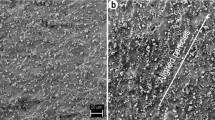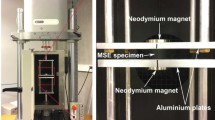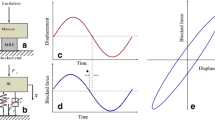Abstract
Experimental study and numerical investigation of stress relaxation behavior of isotropic magnetorheological elastomeric composite (MEC) were carried out in this article. The isotropic MEC was produced from silicone rubber reinforced with micro-sized carbonyl iron particles. The stress relaxation response of the isotropic MEC was investigated at different loading rates, constant strain levels, and under various electromagnetic fields through the single relaxation test with double-lap shear specimens. Research results indicated that the stress relaxation of the isotropic MEC depended slightly on the loading rate, but it was considerably dependent on the constant strain and the electromagnetic field. The shear stress and modulus of the MEC in the relaxation period enhanced with increasing the constant strain and electromagnetic field intensity as well. The stress relaxation of the isotropic MEC was examined numerically using the four-parameter fractional derivative viscoelastic Zener model. The studied fractional derivative viscoelastic model was fitted well to the measured relaxation modulus of the isotropic MEC. The calculated shear stresses of the isotropic MEC with long-term predictions agreed well with the measured ones. Therefore, the investigated fractional derivative viscoelastic model can apply to predict the long-term stress relaxation behavior of the isotropic MEC.
Access provided by Autonomous University of Puebla. Download conference paper PDF
Similar content being viewed by others
Keywords
- Magnetorheological elastomer
- Stress relaxation
- Relaxation test
- Viscoelastic modeling
- Fractional calculus
1 Introduction
Magnetorheological elastomeric composites (MECs) have been prepared by dispersing ferromagnetic powder into a non-magnetic elastomeric matrix. MECs are considered to be intelligent materials due to controllable rheological and mechanical properties under an external magnetic field [1]. The typical behavior of MECs is changing their stiffness and damping properties under the magnetic field. With controllable stiffness and damping properties, MECs have been used in a variety of engineering applications [2]. In addition, MECs are regarded to be viscoelastic composite materials. The mechanical behavior of viscoelastic materials is time-dependent. The time-dependent response of MECs makes them prone to creep and stress relaxation. Therefore, studies of the stress relaxation behavior of MECs are necessary to investigate their viscoelastic properties for long-term applications.
The viscoelastic properties of MECs have been studied numerically using fractional derivative models [3,4,5]. Fractional derivative models based on classical viscoelastic models (Kelvin–Voigt, Maxwell, Zener, etc.) had been built by different combinations of elastic spring and fractional-order dashpot. The fractional derivative models were effective in describing the stress relaxation behavior of polymeric materials [6]. For this paper, the isotropic MEC was developed from silicone rubber and carbonyl iron powders (CIPs). The stress relaxation response of the isotropic MEC was investigated using the single relaxation test with double-lap shear samples. Influences of the loading rate, constant strain, and magnetic flux density (MFD) on the stress relaxation of the MEC were examined. The stress relaxation of the MEC was calculated numerically using a four-parameter fractional derivative viscoelastic Zener model. The model parameters fitting to measured data of the single relaxation test were used to predict the long-term stress relaxation behavior of the isotropic MEC.
2 Experimental Investigation
2.1 Materials
The isotropic MEC was developed using micro-sized CIPs, RTV silicone rubber ZA13, and its catalyst. The micro-sized CIPs (type: 44890), which were provided by Sigma-Aldrich (USA), had overall spherical shapes with 2–5 μm (≥99.5%) in diameter. The RTV silicone rubber ZA13 and its catalyst were developed by Zhermack S.P.A (Italy) and were supplied by Havel Composites Ltd. (Czech Republic).
2.2 Fabrication of Isotropic MEC
The isotropic MEC samples were fabricated by mixing the silicone rubber ZA13, its catalyst, and 27 vol.% CIPs. The processing of the isotropic MEC specimens and their microstructural morphology can be found in detail in our earlier reports [3,4,5].
2.3 Single Relaxation Test
The stress relaxation behavior of the isotropic MEC was investigated via the single relaxation test with double-lap shear specimens. The double-lap shear samples were fabricated by sandwiching two isotropic MEC square blocks between the aluminum slabs. The single relaxation test for the isotropic MEC was performed in the Instron Electropuls testing system at different loading rates (0.01, 0.1, and 1.0/s) and various constant strains (5, 10, 15, and 20%). Besides, the single relaxation test for the MEC samples was conducted with the rise of the MFD up to 0.58 T using an electromagnet. The electromagnet was used to generate magnetic fields with the applied direction perpendicular to the sample shear force. Before each relaxation test, the MEC specimen was loaded cyclically to maximum strain amplitude to eliminate the Mullins effect. The shear force and displacement were recorded for 1000 s in each single relaxation test. The double-lap shear test, the MEC specimen, and the electromagnet system were described in our previous articles [3,4,5].
2.4 Experimental Results
The single shear stress relaxation behavior of the isotropic MEC under a 20% constant strain at different loading rates is described in Fig. 1. The influences of applied constant strains on the shear stress relaxation response of the isotropic MEC are presented in Fig. 2. Shear stresses of the isotropic MEC in the relaxation period as functions of time and the MFD at various constant strain levels are depicted in Fig. 3. The influences of different MFDs on the relaxation modulus of the isotropic MEC at various constant strains are shown in Fig. 4.
The increase in the loading rate resulted in the rise of the shear stress at the same strain (Fig. 1a). Besides, the stress relaxation rate of the isotropic MEC enhances with increasing the loading rate. At the beginning of relaxation, the peak stress at the loading rate of 1.0/s is highest and higher than that at the lower loading rates. The isotropic MEC loaded at a faster rate has greater peak stress than that loaded at a lower rate, because a low rate affords a longer time for the isotropic MEC to relax during loading. Moreover, the modulus relaxation rate increases with the rise of the loading rate (Fig. 1b). However, the shear stress and modulus of the isotropic MEC in the relaxation period after the loading ramp at a lower rate are slightly greater than those at a higher rate. In general, the isotropic MEC exhibits that the higher the loading rate, the greater the stress relaxation rate, but its relaxation modulus does not depend much on the loading rate.
The rise of applied constant strains leads to a significant increase in the shear stress and a slight reduction of the modulus in the relaxation period (Fig. 2). In addition, the shear stress and modulus versus time curves show strongly stress relaxation during the initial 200 s and then indicate an extremely slow rate of relaxation that continues in an asymptotic sense, as reported in [9]. The stress relaxation rate is dependent on the overstress, which is defined as the difference between the current stress and the equilibrium stress. As Fig. 2a shows, the stress relaxation rate increases with raising the strain level. Therefore, the high strain level shows a larger overstress than the low strain level. Generally, the single relaxation test carried out at higher strain levels possessed greater overstresses and showed faster stress relaxation than those at lower strain levels with smaller overstresses, as presented by Amin et al. [10].
As observed in Figs. 3, 4, the shear stress and modulus increase with increasing the MFD. They boost significantly with raising the MFD to about 0.5 T, then enhance somewhat above 0.5 T. The stress relaxation of the MEC is more largely as the MFD rises, so it will take more time to reach the equilibrium state. The enhancement in the relaxation modulus with increasing the MFD is attributable to raising the MR effect of the MEC [4, 5]. The increase in the shear modulus with enhancing the MFD is ascribable to the rise in the magnetic attraction force between CIPs in the MEC. The augmentation of the magnetic force makes CIPs closer, resulting in an increase in the MEC stiffness. The variation in the shear stress and modulus of the MEC is related to the position alternation tendency of CIPs under an electromagnetic field. Once an electromagnetic field is applied to the MEC, the CIPs tend to reach the positions of minimum energy state [4]. The movement of CIPs introduces deformations in the rubber matrix, leading to the rise in the modulus of the MEC [5].
3 Numerical Modeling
3.1 A Fractional Derivative Viscoelastic Model for the MEC
The stress relaxation of the MEC was investigated using the four-parameter fractional derivative Zener model with a Mittag-Leffler function kernel. The model was composed of an elastic spring and a fractional Maxwell element in parallel [6]. The fractional derivative with the Mittag–Leffler function kernel is defined as [7]:
where α is the fractional parameter with value changing between 0 and 1 [7].
The definition of one-parameter Mittag–Leffler function \(M_{{\upalpha }} \left( x \right)\) is given as [8]:
where \(\Gamma \left( {1 + {\upalpha }n} \right)\) is the gamma function with the argument (1 + αn).
The constitutive equation for the four-parameter fractional derivative Zener model in the time domain is expressed as follows:
where E0 and E1 are the elastic moduli of the two springs of the model, and τ is the relaxation time of the fractional dashpot.
The relaxation modulus of the investigated model obtained by the application of the Laplace transform to Eq. (3) is expressed as follows:
3.2 Numerical Simulation Results and Comparison to Experimental Data
The stress relaxation of the isotropic MEC was simulated numerically using the presented model. Equation (4) was used to fit the measured relaxation modulus from the single relaxation test. Four parameters in the vector x = (E0, E1, α, τ)T of the investigated model were obtained by fitting Eq. (4) to the measured data. The least-squares fit of the relaxation modulus to the measured one was conducted by minimizing an objective function with the optimization parameters using the derivative-free method in Matlab.
The model parameters fitting to measured data by minimizing the objective function were given in Tables 1, 2. It is clear from Table 1 that the elastic modulus E0 and the fractional parameter α decreased slightly with increasing the loading rate. As Table 2 shows, the parameter E0 changed slightly with the rise of the applied constant strain. However, the parameter E0 boosted rapidly with raising the MFD to approximately 0.5 T and grew slightly above 0.5 T. The enhancement in the shear modulus of the isotropic MEC with increasing the MFD is corresponding to the magnetic-controllable stiffness of the isotropic MEC. Besides, the fractional parameter α varied irregularly with the rise of the MFD and the constant strain as well (Table 2).
The model fittings of the relaxation modulus to measured data of the isotropic MEC in the single relaxation test at different loading rates, applied constant strains, and under various MFDs were shown in Fig. 5. Results showed the excellent fittings of relaxation modulus to the measured one of the isotropic MEC. In addition, the stress relaxation stress of the isotropic MEC as a function of the time at various loading rates, constant strains, and under different MFDs was calculated using the studied model with estimated parameters, with results described in Fig. 6. The long-term predictions of the shear stress of the isotropic MEC over a wide range of time using the presented model were shown in Fig. 6. Although the stress relaxation was measured in only 1000 s, the studied model can calculate the stress relaxation of the isotropic MEC for a longer time (Fig. 6). The maximal relative error between estimated and measured values within 1000 s for both the relaxation modulus and shear stress is less than 2%. Generally, the four-parameter fractional derivative Zener model was fitted well to experimental data for the isotropic MEC in the single relaxation test. The investigated fractional derivative viscoelastic model can be used for predicting the long-term stress relaxation of the isotropic MEC.
4 Conclusions
Stress relaxation behavior of the isotropic MEC produced from silicone rubber and micro-sized CIPs was investigated experimentally and numerically in this study. Effects of loading rates, applied constant strains, and electromagnetic fields on the stress relaxation of the isotropic MEC were examined. Measured results indicated that the stress relaxation of the isotropic MEC depended slightly on the loading rate, but it was strongly dependent on the applied constant strain and the electromagnetic field. Although the shear stress of the isotropic MEC in the relaxation period enhanced with increasing the constant strain, the relaxation modulus reduced moderately. The shear stress and modulus of the isotropic MEC boosted rapidly with raising the MFD to 0.5 T and increased slightly over 0.5 T. The four-parameter fractional derivative viscoelastic Zener model was fitted well to measured data of the isotropic MEC. The estimated shear stresses of the isotropic MEC with long-term predictions agreed well with the measured ones. The maximal relative error between experimental and calculated values of both shear stress and relaxation modulus is less than 2.0%. In short, the investigated fractional derivative viscoelastic model can apply to predict the long-term stress relaxation behavior of the isotropic MEC.
References
Bastola, A.K., Hossain, M.: A review on magneto-mechanical characterizations of magnetorheological elastomers. Compos. B Eng. 200, 108348 (2020)
Ahamed, R., Choi, C.B., Ferdaus, M.M.: A state of art on magneto-rheological materials and their potential applications. J. Intell. Mater. Syst. Struct. 29(10), 2051–2095 (2018)
Nam, T.H., Petríková, I., Marvalová, B.: Experimental and numerical research of dynamical mechanical properties of magneto-sensitive elastomeric composites. In: Huneau, B., et al. (eds.) Constitutive Models for Rubbers XI, pp. 138–143. Taylor & Francis, UK (2019)
Nam, T.H., Petríková, I., Marvalová, B.: Experimental characterization and viscoelastic modeling of isotropic and anisotropic magnetorheological elastomers. Polym. Test. 81, 106272 (2020)
Nam, T.H., Petríková, I., Marvalová, B.: Experimental and numerical research of stress relaxation behavior of magnetorheological elastomer. Polym. Test. 93, 106886 (2021)
Guo, X., Yan, G., Benyahia, L., Sahraoui, S.: Fitting stress relaxation experiments with fractional Zener model to predict high frequency moduli of polymeric acoustic foams. Mech. Time Depend. Mater. 20(4), 523–533 (2016). https://doi.org/10.1007/s11043-016-9310-3
Atangana, A., Baleanu, D.: New fractional derivatives with nonlocal and non-singular kernel: theory and application to heat transfer model. Therm. Sci. 20, 763–769 (2016)
Niedziela, M., Wlazło, J.: Notes on computational aspects of the fractional-order viscoelastic model. J. Eng. Math. 108(1), 91–105 (2017). https://doi.org/10.1007/s10665-017-9911-0
Haupt, P., Sedlan, K.: Viscoplasticity of elastomeric materials: experimental facts and constitutive modelling. Arch. Appl. Mech. 71, 89–109 (2001)
Amin, A.F.M.S., Lion, A., Sekita, S., Okui, Y.: Nonlinear dependence of viscosity in modeling the rate-dependent response of natural and high damping rubbers in compression and shear: experimental identification and numerical verification. Int. J. Plast. 22, 1610–1657 (2006)
Acknowledgments
This work was supported by the Ministry of Education, Youth and Sports of the Czech Republic and the European Union − European Structural and Investment Funds in the frames of Operational Program Research, Development and Education −project Hybrid Materials for Hierarchical Structures (HyHi, Reg. No. CZ.02.1.01/0.0/0.0/16_019/0000843).
Author information
Authors and Affiliations
Corresponding author
Editor information
Editors and Affiliations
Rights and permissions
Copyright information
© 2022 The Author(s), under exclusive license to Springer Nature Switzerland AG
About this paper
Cite this paper
Nam, T.H., Petríková, I., Marvalová, B. (2022). A Study on Stress Relaxation Behavior of Isotropic Magnetorheological Elastomeric Composite. In: Beran, J., Bílek, M., Václavík, M., Žabka, P. (eds) Advances in Mechanism Design III. TMM 2020. Mechanisms and Machine Science, vol 85. Springer, Cham. https://doi.org/10.1007/978-3-030-83594-1_17
Download citation
DOI: https://doi.org/10.1007/978-3-030-83594-1_17
Published:
Publisher Name: Springer, Cham
Print ISBN: 978-3-030-83593-4
Online ISBN: 978-3-030-83594-1
eBook Packages: EngineeringEngineering (R0)










